PHRF Racing with Spinnaker, Cruising, and Multihull Classes
The 2010 Conquistador Cup Regatta was good practice for light air sailing techniques, much to the disappointment of our Multi-23 crew, as we hoped to blast around the harbor at 20 knots flying two hulls. We were stuck with sailing upwind/downwind course races on Saturday in a very light breeze, then a Swedish Start race on Sunday in which the wind dropped off to zero at one point and we wound up stopped and facing the wrong direction. Still, a frustrating day sailing beats a good day working!
The Spaniards who colonized Florida in the 16th century are an important part of our cultural heritage here, and the Royal Order of Ponce De Leon Conquistadors is a civic organization dedicated to the preservation of Spanish heritage in Southwest Florida. Every year, they host the Conquistador Cup Regatta, in which dozens of sailboats from around the region compete in PHRF handicap racing events on Saturday, then the whole fleet does a "reverse start" race on Sunday. The first boat over the line wins and gets their picture crossing the line put on the next year's t-shirt, a huge honor in the sailing world!
There were over 70 boats participating in the 2010 Conquistador Cup, divided into two classes each of spinnaker, non-spinnaker, and cruising monohulls and a multihull fleet consisting of two Corsair F-24's, two Stiletto 27s, a Dolphin 46, and the Multi 23 on which I was racing.

On Saturday we did two races on upwind/downwind courses around buoys, and the Corsair F-24s Tri Power and Consensus beat up on us pretty badly. In the picture, you can see one out in front of us — it is not supposed to be there! We actually have to give that boat time on the PHRF ratings, so we need to beat them by a certain amount just to score even with them on corrected time for the race. If they are in front of us, it generally means we're doing things wrong and they are doing them right. The winds were so light that the Stilettos and the Dolphin 46 were unable to finish within the time limit for the races so we took third place by managing to finish within the prescribed time.
We did better in the second race than the first one, not getting beaten quite as badly by the Corsairs we were supposed to beat. We are still working out the basics of racing this boat effectively, and were up against some very seasoned multihull racers, so we didn't feel too bad about losing and the experience helped us learn a few more details on how to change sails at the marks smoothly. I thought I learned a thing or two about properly timing the start sequence to get the boat over the line on time with good speed on, but Sunday's start showed I still have a few things to learn!

After the first race, the wind briefly died out completely, delaying the start of our second race. We waited near the committee boat, and after a while could see the dark ripples on the harbor to the west, indicating that the afternoon sea breeze was starting to come ashore. Once the wind ripples worked their way across the harbor to our position, the mark set boat ran our upwind mark out in the new wind direction and we started another race, this time going the opposite direction from the morning race. That's light air racing in Charlotte Harbor!

We got a better start and did manage to get out ahead of some of the spinnaker fleet boats during the second race. We were not far enough ahead to beat them on corrected time, but it is nice to at least be looking over the stern at them!

The traditional Sunday race for the Conquistador Cup is a Swedish Start (also called reverse start) race, in which the slowest boat in the fleet starts, then each faster boat starts at a predetermined interval afterwards. The idea is that if all boats sailed exactly to their respective PHRF ratings, we would all cross the finish line at the same moment. There is no second place in this kind of race, and no one keeps time on each boat. The first boat to cross the line wins and gets a picture on the next year's t-shirt, and all other boats lose. With the fastest PHRF rating in the fleet, we were to start last, almost 40 minutes after the first boat departed. During the prestart period, I took the opportunity to get some pictures of some of the boats. I think Lea, with her green hull and golden sails, is one of the nicest looking boats on Charlotte Harbor.

Midnite Rider, a Tartan 4100, always does well in this race, and is memorialized on the official Conquistadors site finishing just ahead of my old Corsair F-27, Surrender, in this same race a few years ago.

Coming home from Saturday's races, I had spotted something strange across the harbor. It looked to me like someone had a jib that was stuck up, and for some reason the boat was being towed home backward. A few minutes later, the "jib" dropped, and the boat came motoring by. It was a strange one, a double ended schooner, with the two masts attached to each other to form an A, and the sail I had seen was flying on the aft mast and boom. I spotted the boat warming up in the start area before Sunday's race, and drove over there to get a picture of it under sail. I later learned that the owner had fashioned this boat out of an old Seaward 24 and another boat, and designed the unique rig himself. He gets points for creativity, and dominated his fleet in Saturday's racing!

We were zipping around the start area at up to ten knots under just the leisure main and jib on the Multi 23, and decided to kill a little time before the race by going up to the windward mark to find the angle at which we would later approach it. With the nice breeze, we actually stood some small chance of passing over 70 boats and finishing first in the race, as happened in the past with a Farr 40 and a Farrier 33. The Multi 23 was tearing along and leaving a frothy wake, and we were not even trying to go fast yet!

We did not see much of the Corsair F-24s on Sunday, as they started ahead of us just before the wind died and were long gone by the time we started. I did manage to catch Consensus on camera warming up in the start area under main and jib.

The race start/finish line was located between markers 3 and 3A, and the race went upwind to marker 4, down around marker 2, on around marker 1, back around 2, and back to the line. The line was a "closed gate," meaning boats not starting or finishing were not allowed to cross the line.
When our time finally came to start, the rest of the fleet was already returning past the start area. They were not allowed to cross the start/finish line, but were streaming by on each side in a nearly continuous line as we tacked back and forth along the line. The wind, which had been nice all morning, began to die. I did not want to get stuck out of position, and could not rely on our speed to quickly get us in position, so taking a conservative approach, I arrived in the area we wanted to be just a bit early. The problem then was to stay in place and burn up some time, and I started zig zagging as we let the sails way out.
Right about then, a puff of wind came along, and our efforts to bleed off speed were unsuccessful. We were running out of room, and in danger of crossing the starting line too soon, so I made a quick decision to do a 360-degree turn. It would have worked out well, had I paid enough attention to mainsail trim during the turn. I did not, and allowed the boat to lose too much speed to successfully complete the last part of the turn through the eye of the wind. Sensing that I was about to put the boat in irons, I made matters even worse by reversing the rudder a moment too soon.
There we were, stuck in irons just behind the committee boat, where the race committee looked in other directions in a very dignified fashion. I would have laughed at our plight! The rest of the fleet certainly were, and I can only hope none of them were prepared with cameras at that moment. After backwinding the jib and steering the boat backwards briefly, we came out of irons and began slowly sailing in the dying wind toward the line, probably a couple of minutes late for our start. We were just starting to get some speed when a couple of large Sea Ray cabin cruisers came out the Fisherman's Village channel and picked the only path in the harbor that was clear of sail boats to get on plane and speed away: the path leading to the start/finish line. After they passed by, their wake brought us to a slamming stop and briefly threw us backward. We struggled through the chop and were finally under way, with an entire fleet of boats in front of us, all of which we had to somehow pass. It did not seem likely.

Despite our travails at the starting line, we did OK upwind in the light air. We passed one of the Stiletto 27s before rounding marker 4, and passed the other shortly afterward. My wife and brother, out in our 15' Boston Whaler to take pictures and video of the race, caught this picture of the three boats up near marker 4.

I caught both of the Stilettos just as they set their spinnakers.

Shortly afterward, I got a picture of our 15 Whaler serving as photo boat while they were videotaping and taking pictures of us.

That was the last we saw of our photo boat that day. They followed the fleet down the center of the harbor, while we took an angle off toward the north side of the harbor. We might as well have fallen off the edge of the earth. There was no wind over there, and we wound up slowly passing by a Corsair F-24 that was not participating in the race with a combined closing speed of perhaps a knot.

We passed by the struggling Dolphin 46, Route 66, as they were almost stopped in the light air. We taunted them and they menaced us with boathooks and pirate talk. They were stopped, and destined to lose, but had a very stable beer drinking platform. We were still moving, but did not have much chance of catching the entire fleet, and did not even bring along beer!

We were averaging less than a knot heading down toward marker 1, and looking back across glassy water at the rest of the fleet, we saw that many of them were already approaching the finish line. Soon the announcement from the committee boat came over the radio that the first boat had finished, and the rest of us might as well go home.

It was not such a great day for a fast sailboat, but a good day for a fast powerboat, and a couple of them were blasting around as a sea breeze started to pick up to carry us home.

It was not our day to win the reverse start race, even if we had done everything right, but it looked like a fun day for the other multihull boats on the harbor. Prior to the race we saw local catamarans Kahuna and Tigger

On our way back in we passed by this small catamaran motorsailer cruiser, moving under power as cruisers frequently do, but looking like a roomy little package, and this large catamaran powerboat, complete with dinghy on the foredeck and kayak suspended from what can only be called the back porch roof. Those look like a couple of fun Bahamas cruisers to me!

Some video of the Sunday race in the 2010 Conquistador Cup Regatta:
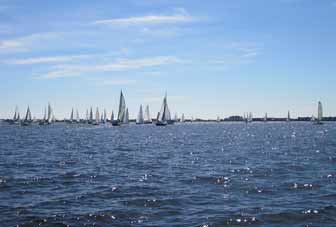
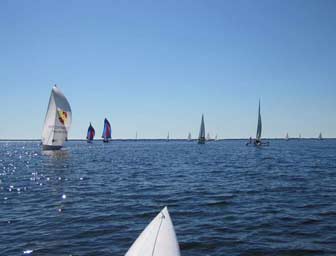
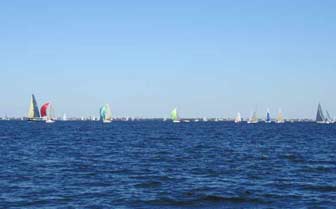
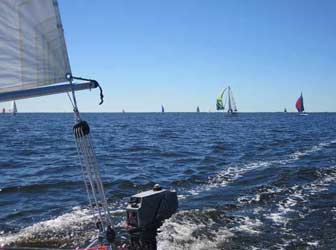
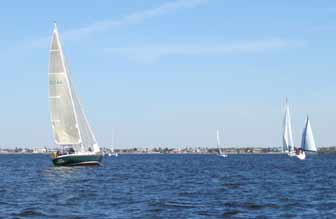
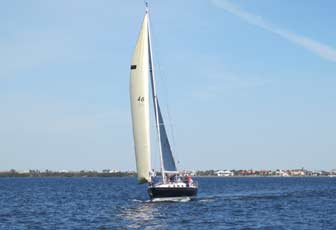
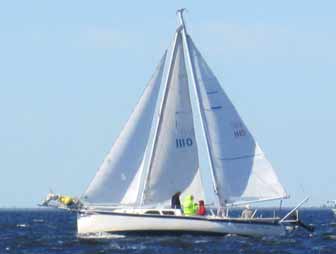
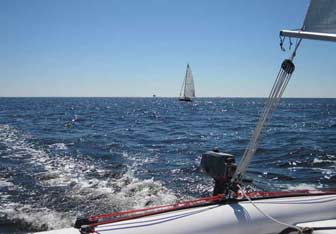
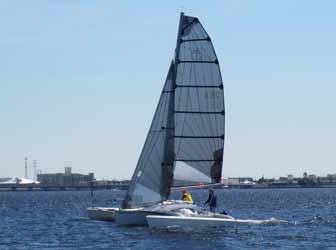
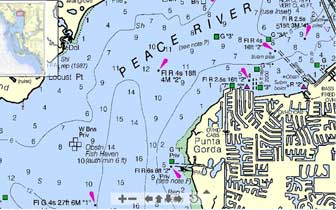
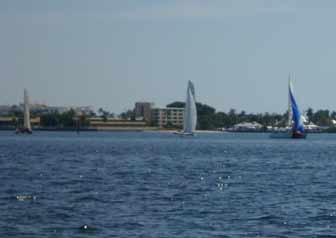
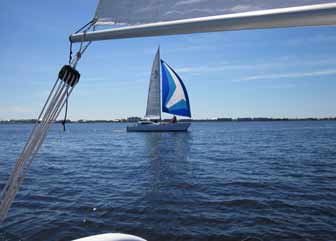
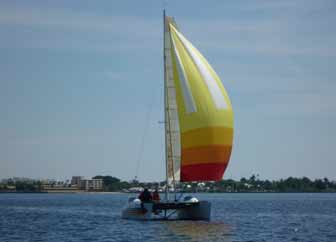
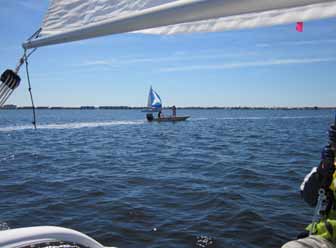
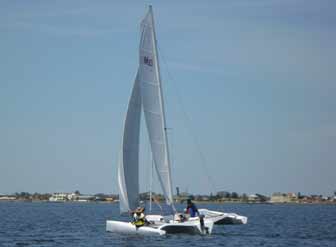
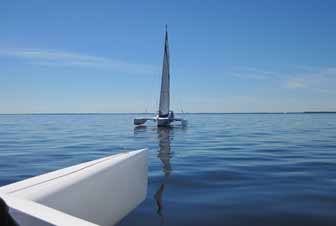
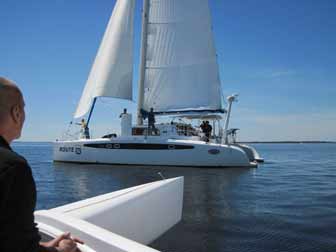
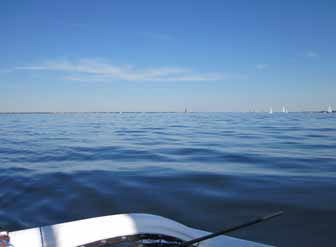
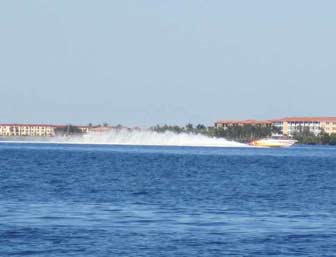
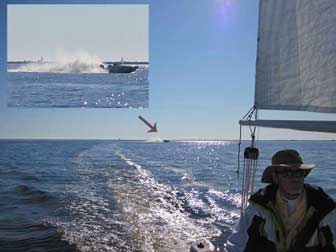
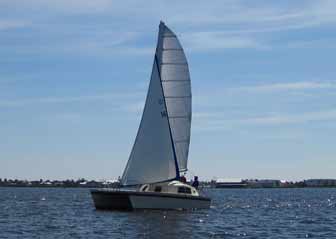
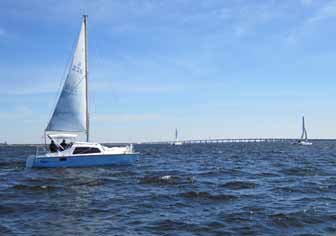
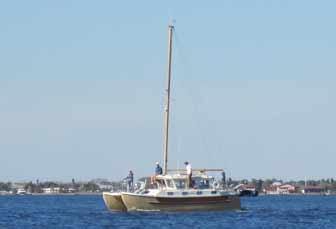
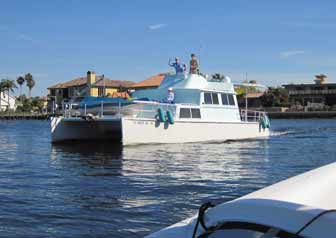
Leave a Reply
You must be logged in to post a comment.